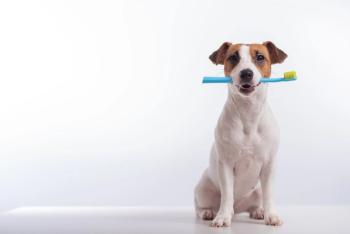
Feline oral disease (Proceedings)
Cats are different! Being obligate carnivores, they do not have chewing teeth, but instead have carnassial teeth that aid to cut up their food into manageable pieces.
Cats are different! Being obligate carnivores, they do not have “chewing teeth”, but instead have carnassial teeth that aid to cut up their food into manageable pieces. Commercial diets do not provide the dietary abrasion that comes from a natural wild state diet. Even a wild state diet only retards, but does not prevent the accumulation of plaque. The feline oral pH is slightly alkaline, which makes dental caries unlikely, however promotes deposition of dental calculus.
Cats have different oral anatomy:
Cats have fewer teeth than our canine companions. They lack an upper (maxillary) first pre-molar and lower (mandibular) first and second pre-molars. They have only a small functionless upper (maxillary) first molar. The dental formula for the cat is:
·Kitten: 2x (I3/3,C1/1,P3/2)=26
·Adult: 2x (I3/3,C1/1,P3/2,M1/1)=30
·Cats also have a mandibular molar salivary gland.
Sulcus:
The sulcus depth in the cat is much shallower than found in the dog. The normal sulcus depth is 0.5-1 mm; anything greater would be considered abnormal.
Common disorders found in cats
Periodontal disease
A study in 1996 by Dr. Lund published in the Journal of Veterinary Dentistry (issue 13) looked at several thousand cats. Oral disease was diagnosed only second to a healthy state as the primary disease in cats ranging from 0 to 7 years of age, and was the most common diagnosis in older cats. Up to 80% of mature cats have at least mild gingivitis (initial stage) around some or all teeth, and 50% of cats age 4 or older will have periodontitis present at one or more teeth.
Tooth resorption
The terminology was officially changed by the AVDC to tooth resorption due to the fact that this condition is found not only in cats, but can also be seen in dogs and primates. The cause of the condition is unknown at this time, but several theories are being investigated. Tooth resorption is classified into 5 stages:
·Stage 1 (TR1)- Mild dental hard tissue loss such as cementum or cementum and enamel.
·Stage 2 (TR2)- Moderate dental hard tissue loss such as cementum or cementum and enamel with loss of dentin that does not extend to the pulp cavity.
·Stage 3 (TR3)- Deep dental hard tissue loss, for example, cementum or cementum and enamel with loss of dentin that extends into the pulp cavity. Most of the tooth retains its integrity.
·Stage 4 (TR4)- Extensive dental hard tissue loss such as cementum or cementum and enamel with loss of dentin that extends into the pulp cavity. Most of the tooth has lost its integrity.
·Stage 4a (TR4a)- Crown and root are equally affected
·Stage 4b (TR4b)- Crown is more severely affected than root.
·Stage 4c (TR4c)- Root is more severely affected than crown.
·Stage 5 (TR5)- Remnants of dental hard tissue are visible only as irregular radiopacities, and gingival covering is complete.
Intra-oral radiographs are an extremely important diagnostic tool for the discovery (diagnostics) and treatment of these lesions.
Gingivostomatits/stomatitis
Stomatitis is a general term used to describe an inflammation of the oral mucosa, which includes the buccal and labial mucosa, palate, tongue, floor of mouth, and the gingiva. The cause of stomatitis is still unknown, but and immune mediated process is theorized.
Chronic Osteitis or Alveolitis
Most commonly associated with the maxillary canines, with a bulging of the alveoli. Can also involve the mandibular symphysis region. Periodontal pockets are usually found due to chronic inflammation. Many times affected canine teeth are loose due to the disease process and should be treated, most commonly by extraction; however closure of these sites can be difficult.
Supereruption or extrusion
This condition can be seen with chronic aveolitis and periodontal disease of the maxillary and mandibular canines, resulting in the tooth slowly being pushed out from the socket.
Oral Masses
Asymmetrical lesions demand attention. Neoplastic vs. non-neoplastic oral tumors make up 3% of cancers in cats.
·Squamous cell carcinoma (SCC)
SCC is by far the most common malignant tumor is cats ( up to 70%). It tends to be locally invasive, and will cause lysis of bone. The patient may present with loose teeth. Oral squamous cell carcinoma in cats grows rapidly, ulcerates and become secondarily infected early in the course of the disease. These tumors tend to spread late in the course of the disease and are relatively sensitive to radiation therapy (1). Prognosis for these patients is poor. Radiation therapy can help to slow the progression of the disease, but can be cost prohibitive.
·Fibrosarcoma
The second most common tumor in feline patients. They are a slow growing and invasive tumor. FSA account for about 10 – 20% of oral tumors in cats.
References
“Recognition and Treatment of Oral Tumors”Sandra Manfra Marretta, DVM, Diplomate, ACVS, AVDC ?University of Illinois,
“Canine and Feline oral tumors:Earlier is better” Cronin,Kim, DVM:The Newsmagazine of Veterinary Medicine; Jul 2006, Vol. 37 Issue 7, p6s-11s,4p.
Feline Medicine and Therapeutics 3rd Ed. “The Oral Cavity”, E. Chandler, C. Gaskell, and R. Gaskell, Blackwell publishing 2007
Recent Advances in Small Animal Dentistry, D.T. Carmicheal, International Veterinary Information Service (www.ivis.org), Ithaca, New York, USA.
Newsletter
From exam room tips to practice management insights, get trusted veterinary news delivered straight to your inbox—subscribe to dvm360.



